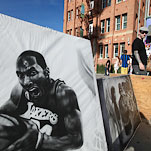LAS VEGAS — The recipe for disaster in auto racing is hardly a secret. Start with a problematic racing layout, mix in a field of expert drivers with rookies and rusty ones, put millions of dollars on the line and then add speed. Lots of speed.
Worries Circled Las Vegas Track Before a Pileup

Las Vegas Motor Speedway is a steeply banked oval that drivers say is better suited to stock cars.
By JERRY GARRETT
Published: October 17, 2011
Multimedia
Related
-
Back Home, Known for a Tragedy, Not Successes (October 18, 2011)
-
Wheldon, Indy 500 Winner, Dies After Crash (October 17, 2011)
Michael Conroy/Associated Press
A visitor sat a makeshift memorial at the Indianapolis Motor Speedway for driver Dan Wheldon on Monday.
On Sunday, the recipe produced one of the worst crashes in the history of Indy-car racing: a 15-car smashup that left the British driver Dan Wheldon, a two-time winner of the Indianapolis 500, dead at 33.
The problematic track was Las Vegas Motor Speedway, a steeply banked mile-and-a-half oval more suited to stock car racing. The first Indy car race run there in 1996 was plagued by crashes, and the two subsequent races there proved no safer.
“There’s zero margin for error,” James Hinchcliffe, the driver who said his car started the deadly crash, said in its aftermath. “Zero time to react.”
The influence of money came in the form of a $2.5 million bonus Wheldon would have won if he had pulled off what many drivers regarded as little more than a dangerous stunt: agree to start at the back of the pack and see if he could thread his way through slower, less-experienced drivers to win.
Wheldon, who was wildly talented but who had barely raced in 2011, acknowledged beforehand that the money was why he risked racing rusty.
And then there was speed. Practice runs had yielded high speeds and at least one serious crash — James Jakes, a rookie driver, hit a wall Friday at more than 220 miles per hour. Wheldon — “I’m hitting 221 miles per hour on the backstretch,” he said after a practice session Friday — told others that he felt a bit overwhelmed at those speeds, in a largely unfamiliar car.
“You could feel the fear,” the driver Adrián Fernández said of time he spent with Wheldon in his motor home before the start of the race.
On Monday, IndyCar Series officials responsible for the race had not spoken publicly about any issues the fatal crash had raised. But prominent drivers were quick in calling for rethinking all or parts of IndyCar.
Jimmie Johnson, a five-time Nascar champion, said flatly, “Indy cars should only be racing on road courses — not ovals.”
Danica Patrick, who is leaving the sport to concentrate on stock cars next year, said she would not miss IndyCar’s zero-margin-for-error style. She lamented worrying about looking “like a wimp,” if she erred on the side of safety — taking her foot off the gas pedal so as to avoid winding up in a crash like Sunday’s.
“But you know what?” she admitted, “I lifted a little.”
The Las Vegas track, which opened in 1995, was built for a reported cost of $72 million. The track was purchased for $215 million in 1998 by Speedway Motorsports Inc., which owns other tracks in Charlotte, N.C.; Atlanta; and Fort Worth.
The layout had a basic problem: its oval had been constructed with rather illogical angles and degrees of banking, requiring continual adjustments by drivers accustomed to setting the steering wheel at a given angle and maintaining an expected trajectory. Drivers complained of not being able to find a smooth, safe racing line.
A race for Indy cars there in 1996 was called a crash-filled bore, in which the safety car led more laps than the winner.
Two subsequent races by the open-wheel cars produced no more satisfying results. The cars stopped racing there in 2000.
“I don’t know what I’d suggest to fix it,” Nascar’s Dale Earnhardt Jr. said at the time, “other than to dig it up and start over.”
Over the years, and the course of many changes, costing untold millions of dollars, that is essentially what Speedway Motorsports did. The most recent change, five years ago, increased the angle of the banking from 12 to 20 degrees. Average lap speeds jumped by more than 10 m.p.h. Sturdier stock cars seemed better suited to handle the increased danger that came with the increased speed.
- 1
- 2










